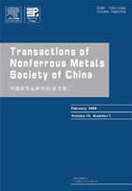Angular deviations and influential factors of Burgers orientation relationship during β→α phase transformation in titanium alloys
(1. School of Materials Science and Engineering, Beihang University, Beijing 100191, China;
2. Key Laboratory of Advanced Titanium Alloys, Beijing Institute of Aeronautical Materials, Aero Engine Corporation of China, Beijing 100095, China;
3. MIIT Key Laboratory of Advanced Metallic and Intermetallic Materials Technology, Nanjing University of Science and Technology, Nanjing 210094, China;
4. Tianmushan Laboratory (Zhejiang Provincial Laboratory for Aviation), Hangzhou 311312, China)
2. Key Laboratory of Advanced Titanium Alloys, Beijing Institute of Aeronautical Materials, Aero Engine Corporation of China, Beijing 100095, China;
3. MIIT Key Laboratory of Advanced Metallic and Intermetallic Materials Technology, Nanjing University of Science and Technology, Nanjing 210094, China;
4. Tianmushan Laboratory (Zhejiang Provincial Laboratory for Aviation), Hangzhou 311312, China)
Abstract: The angular deviations and influential factors of Burgers orientation relationship (BOR) in Ti-6Al-4V and Ti-6.5Al-2Zr-1Mo-1V alloys were investigated by optical microscope (OM), scanning electron microscope (SEM), electron backscattered diffraction (EBSD) and high-angle annular dark-field scanning transmission electron microscope (HAADF-STEM). A spherical center angle model was introduced to calculate the angular deviations from the ideal BOR between α and β phases. The results indicate that α and β phases in α colonies of both alloys do not follow the perfect BOR during β→α phase transformation, with angular deviation values less than 3°. Through detailed microstructure characterization, the broad face of α/β interfaces viewed along two different electron incident directions shows the atomic-scale terrace-ledge structure, and many dislocations are observed within α and β phases and near α/β interfaces. Further studies reveal that the angular deviations mainly originate from lattice distortions caused by dislocations in α and β phases and lattice mismatches at α/β interfaces.
Key words: titanium alloy; Burgers orientation relationship; angular deviation; α/β interface; dislocation; lattice distortion

